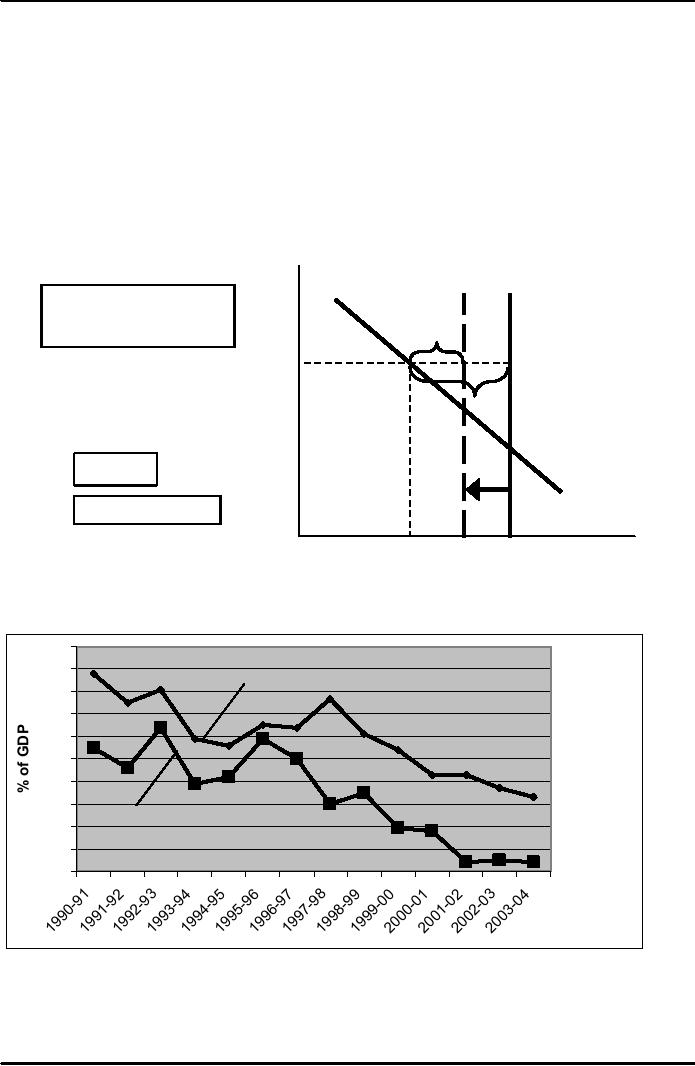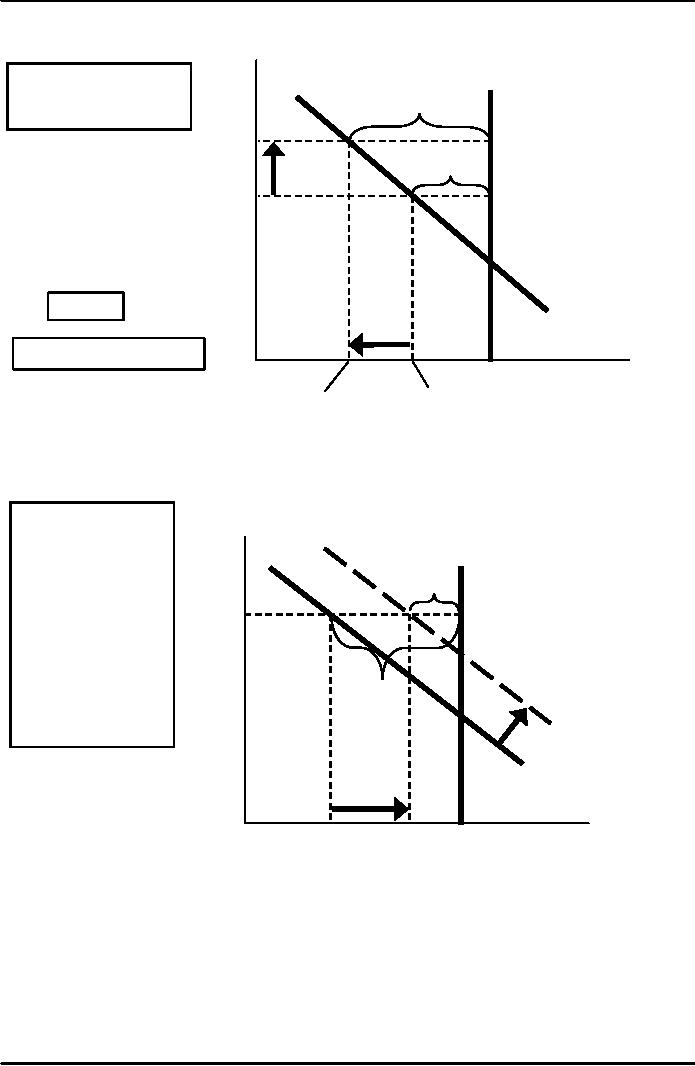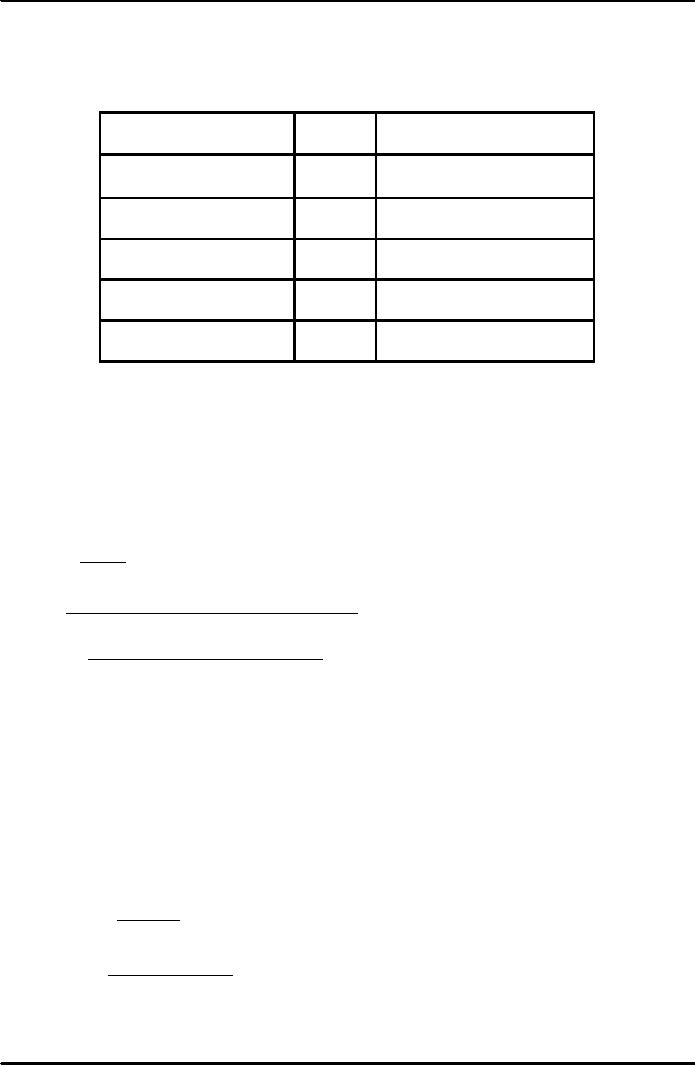 |
OPEN ECONOMY:Three experiments, The nominal exchange rate |
| << MONEY AND INFLATION (Continued…):The Classical Dichotomy |
| OPEN ECONOMY (Continued…):The Determinants of the Nominal Exchange Rate >> |

Macroeconomics
ECO 403
VU
LESSON
15
OPEN
ECONOMY
Three
experiments
1.
Fiscal
policy at home
2.
Fiscal
policy abroad
3.
An
increase in investment
demand
1.
Fiscal policy at
home
r
S2
S1
An
increase in G
or
decrease
in T
reduces
NX2
saving.
r1*
NX1
Results:
ΔI
= 0
I
(r)
ΔNX
= ΔS
< 0
S,
I
I1
NX
and the Govt. Budget
Deficit
10
9
Budget
Deficit
8
7
6
5
4
3
Net
Export Deficit
2
1
0
52

Macroeconomics
ECO 403
VU
2.
Fiscal policy
abroad
r
S1
Expansionary
fiscal
NX2
policy
abroad raises
the
world interest rate.
r2*
NX1
r1*
Results:
ΔI
< 0
I
(r )
ΔNX
= -ΔI
> 0
S,
I
I
(r2*)
I
(r1*)
3.
An increase in investment
demand
ΔI
> 0,
r
ΔS
= 0,
S
net
capital
outflows
and net
NX2
exports
r *
fall
by the amount
ΔI
NX1
I
(r )2
I
(r )1
S,
I
I2
I1
The
nominal exchange
rate
e
= nominal exchange rate, the
relative price of domestic
currency in terms of foreign
currency
(e.g.
Yen per Dollar)
53

Macroeconomics
ECO 403
VU
Exchange
rates as of February 26,
2005
Country
Currency
exchange
rate
Europe
Euro(�)
Rs.
78.53
Japan
Yen(�)
Rs.
0.5642
U.K.
Pound(�)
Rs.
113.99
United
States
Dollar($)
Rs.
59.32
UAE
Dirham
Rs.
16.15
The
real exchange
rate
ε
=
real exchange rate, the
relative price of domestic
goods in terms of foreign
goods (e.g.
Japanese
Big Macs per U.S.
Big Mac)
Understanding
the units of ε
e
�P
ε
=
P*
(Yen
per $) �
($
per unit U.S. goods)
=
Yen
per unit Japanese
goods
Yen
per unit U.S. goods
=
Yen
per unit Japanese
goods
Units
of Japanese goods
=
per
unit of U.S. goods
~
Example ~
�
One good:
Burger
�
Price in Japan:
P* = 200 Yen
�
Price in USA: P
= $2.50
�
Nominal
exchange rate, e = 120
Yen/$
e
�P
ε
=
P *
1
2 0 �
$ 2 .5
0
=
=
1
.5
200
Yen
54

Macroeconomics
ECO 403
VU
To
buy a U.S. burger, someone
from Japan would have to
pay an amount that could
buy 1.5
Japanese
Burgers.
ε
in
the real world & our
model
�
In
the real world:
We
can think of ε
as
the relative price of a
basket of domestic goods in
terms of a
basket
of foreign goods
�
In
our macro model:
There's
just one good, "output." So
ε is the
relative price of one
country's output in
terms
of the other country's
output
How
NX
depends
on ε
↑ε ⇒
US
goods become more expensive
relative to foreign goods
⇒
↓EX,
↑IM
⇒
↓NX
55
Table of Contents:
- INTRODUCTION:COURSE DESCRIPTION, TEN PRINCIPLES OF ECONOMICS
- PRINCIPLE OF MACROECONOMICS:People Face Tradeoffs
- IMPORTANCE OF MACROECONOMICS:Interest rates and rental payments
- THE DATA OF MACROECONOMICS:Rules for computing GDP
- THE DATA OF MACROECONOMICS (Continued…):Components of Expenditures
- THE DATA OF MACROECONOMICS (Continued…):How to construct the CPI
- NATIONAL INCOME: WHERE IT COMES FROM AND WHERE IT GOES
- NATIONAL INCOME: WHERE IT COMES FROM AND WHERE IT GOES (Continued…)
- NATIONAL INCOME: WHERE IT COMES FROM AND WHERE IT GOES (Continued…)
- NATIONAL INCOME: WHERE IT COMES FROM AND WHERE IT GOES (Continued…)
- MONEY AND INFLATION:The Quantity Equation, Inflation and interest rates
- MONEY AND INFLATION (Continued…):Money demand and the nominal interest rate
- MONEY AND INFLATION (Continued…):Costs of expected inflation:
- MONEY AND INFLATION (Continued…):The Classical Dichotomy
- OPEN ECONOMY:Three experiments, The nominal exchange rate
- OPEN ECONOMY (Continued…):The Determinants of the Nominal Exchange Rate
- OPEN ECONOMY (Continued…):A first model of the natural rate
- ISSUES IN UNEMPLOYMENT:Public Policy and Job Search
- ECONOMIC GROWTH:THE SOLOW MODEL, Saving and investment
- ECONOMIC GROWTH (Continued…):The Steady State
- ECONOMIC GROWTH (Continued…):The Golden Rule Capital Stock
- ECONOMIC GROWTH (Continued…):The Golden Rule, Policies to promote growth
- ECONOMIC GROWTH (Continued…):Possible problems with industrial policy
- AGGREGATE DEMAND AND AGGREGATE SUPPLY:When prices are sticky
- AGGREGATE DEMAND AND AGGREGATE SUPPLY (Continued…):
- AGGREGATE DEMAND AND AGGREGATE SUPPLY (Continued…):
- AGGREGATE DEMAND AND AGGREGATE SUPPLY (Continued…)
- AGGREGATE DEMAND AND AGGREGATE SUPPLY (Continued…)
- AGGREGATE DEMAND AND AGGREGATE SUPPLY (Continued…)
- AGGREGATE DEMAND IN THE OPEN ECONOMY:Lessons about fiscal policy
- AGGREGATE DEMAND IN THE OPEN ECONOMY(Continued…):Fixed exchange rates
- AGGREGATE DEMAND IN THE OPEN ECONOMY (Continued…):Why income might not rise
- AGGREGATE SUPPLY:The sticky-price model
- AGGREGATE SUPPLY (Continued…):Deriving the Phillips Curve from SRAS
- GOVERNMENT DEBT:Permanent Debt, Floating Debt, Unfunded Debts
- GOVERNMENT DEBT (Continued…):Starting with too little capital,
- CONSUMPTION:Secular Stagnation and Simon Kuznets
- CONSUMPTION (Continued…):Consumer Preferences, Constraints on Borrowings
- CONSUMPTION (Continued…):The Life-cycle Consumption Function
- INVESTMENT:The Rental Price of Capital, The Cost of Capital
- INVESTMENT (Continued…):The Determinants of Investment
- INVESTMENT (Continued…):Financing Constraints, Residential Investment
- INVESTMENT (Continued…):Inventories and the Real Interest Rate
- MONEY:Money Supply, Fractional Reserve Banking,
- MONEY (Continued…):Three Instruments of Money Supply, Money Demand